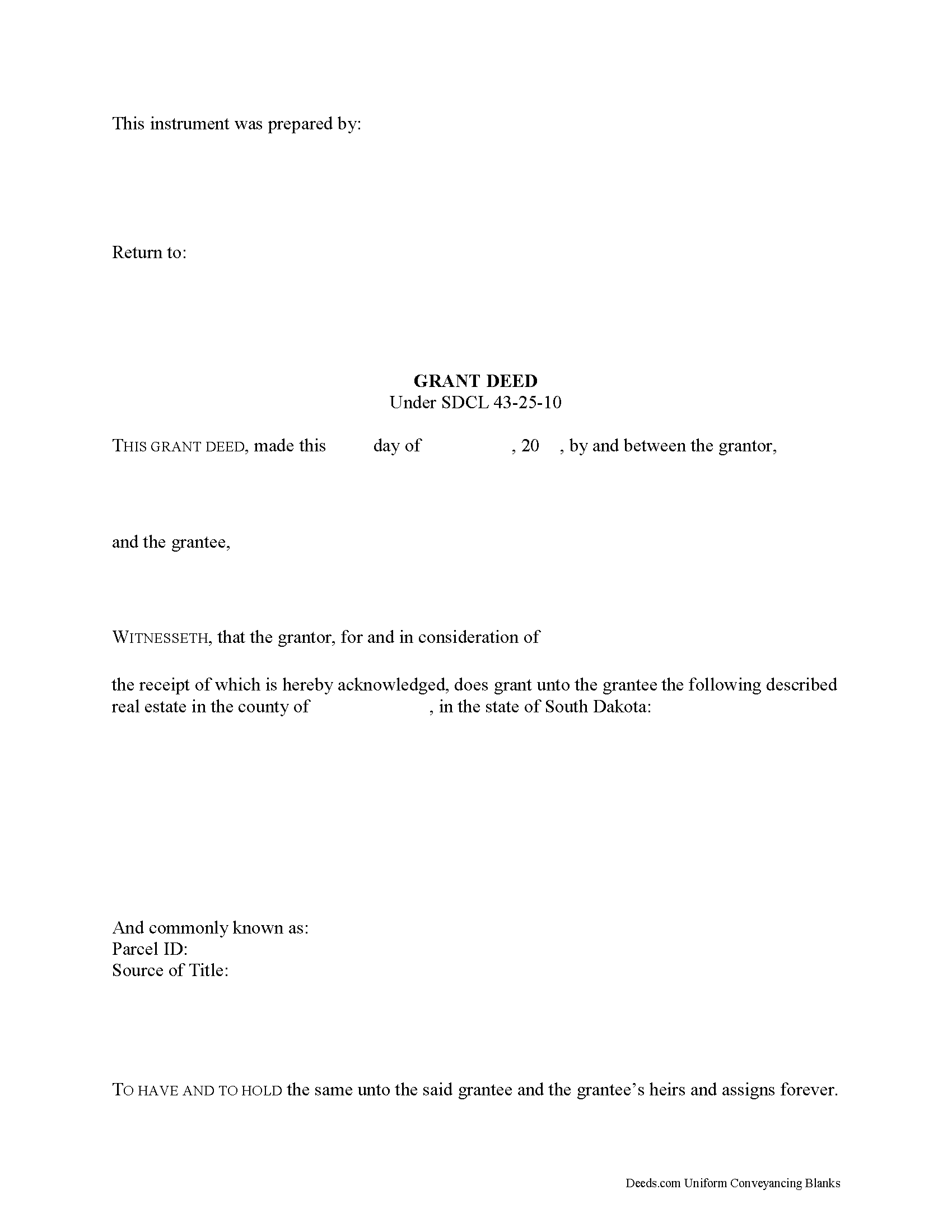South Dakota Grant Deed
County Specific Legal Forms Validated as Recently as August 21, 2025

About the South Dakota Grant Deed

How to Use This Form
- Select your county from the list on the left
- Download the county-specific form
- Fill in the required information
- Have the document notarized if required
- Record with your county recorder's office
What Others Like You Are Saying
“Downloaded perfect. Can hardly wait to get them done.”
— Dennis D.“great experience. Great communication and very fast turn around ty Adriane”
— Adriane L.“Very handy when clueless about filling out a form. Saved hours of research.”
— Dave W.“Excellent service, very reliable.”
— John F.“Great site. It lets your fingers do the walking. It took me half a day to get deed info a couple of …”
— Mercedes B.
In South Dakota, title to real property can be transferred from one party to another by executing a grant deed. Use a grant deed to transfer title with the implied covenants that guarantee that the title is free of any encumbrances (except for those stated in the deed) and that the grantor holds an interest in the property and is free to convey it (43-25-10). The word "grant" in the conveyancing clause transfers fee simple title (SDCL 43-25-10).
Grant deeds offer the grantee (buyer) more protection than quitclaim deeds, but less than warranty deeds. A grant deed differs from a quitclaim deed in that the latter offers no warranty of title, and only conveys any interest that the grantor may have in the subject estate. A warranty deed offers more surety than a grant deed because it requires the grantor to defend against claims to the title.
A lawful grant deed includes the grantor's full name, mailing address, and marital status; the consideration given for the transfer; and the grantee's full name, mailing address, marital status, and vesting. Vesting describes how the grantee holds title to the property. Generally, real property is owned in either sole ownership or in co-ownership. For South Dakota residential property, the primary methods for holding title are tenancy in common and joint tenancy. A conveyance of real estate to two or more persons creates a tenancy in common, unless a joint tenancy is expressly created (43-2-11 et seq).
As with any conveyance of realty, a grant deed requires a complete legal description of the parcel. Recite the prior deed reference to maintain a clear chain of title, and detail any restrictions associated with the property. The completed deed must be acknowledged by the grantor (and his or her spouse, if applicable) in the presence of a notary. Finally, the document must meet all state and local standards of form and content for documents pertaining to real property in South Dakota. See SDCL 43-28-23.
A transfer fee is levied based on the consideration paid. Pursuant to SDCL 43-4-23, if the transfer is exempt from the transfer fee, the deed should cite any exemption claimed. A list of exemptions can be found at 43-4-22. Real estate transfer fees are due upon recording, unless an exemption is claimed. Contact the appropriate Register of Deeds office for up-to-date information on transfer fees. The deed must also be recorded with a Certificate of Real Estate Value (SDCL 7-9-7(4)).
Record the original completed deed, along with any additional materials, at the Register of Deeds office in the county where the property is located. Contact the appropriate Register of Deeds to verify accepted forms of payment.
This article is provided for informational purposes only and is not a substitute for the advice of an attorney. Contact a South Dakota lawyer with any questions related to grant deeds or the transfer of real property.
(South Dakota GD Package includes form, guidelines, and completed example)
Important: County-Specific Forms
Our grant deed forms are specifically formatted for each county in South Dakota.
After selecting your county, you'll receive forms that meet all local recording requirements, ensuring your documents will be accepted without delays or rejection fees.
How to Use This Form
- Select your county from the list above
- Download the county-specific form
- Fill in the required information
- Have the document notarized if required
- Record with your county recorder's office
What Others Like You Are Saying
“Downloaded perfect. Can hardly wait to get them done.”
— Dennis D.“great experience. Great communication and very fast turn around ty Adriane”
— Adriane L.“Very handy when clueless about filling out a form. Saved hours of research.”
— Dave W.“Excellent service, very reliable.”
— John F.“Great site. It lets your fingers do the walking. It took me half a day to get deed info a couple of …”
— Mercedes B.Common Uses for Grant Deed
- Transfer property between family members
- Add or remove names from property titles
- Transfer property into or out of trusts
- Correct errors in previously recorded deeds
- Gift property to others